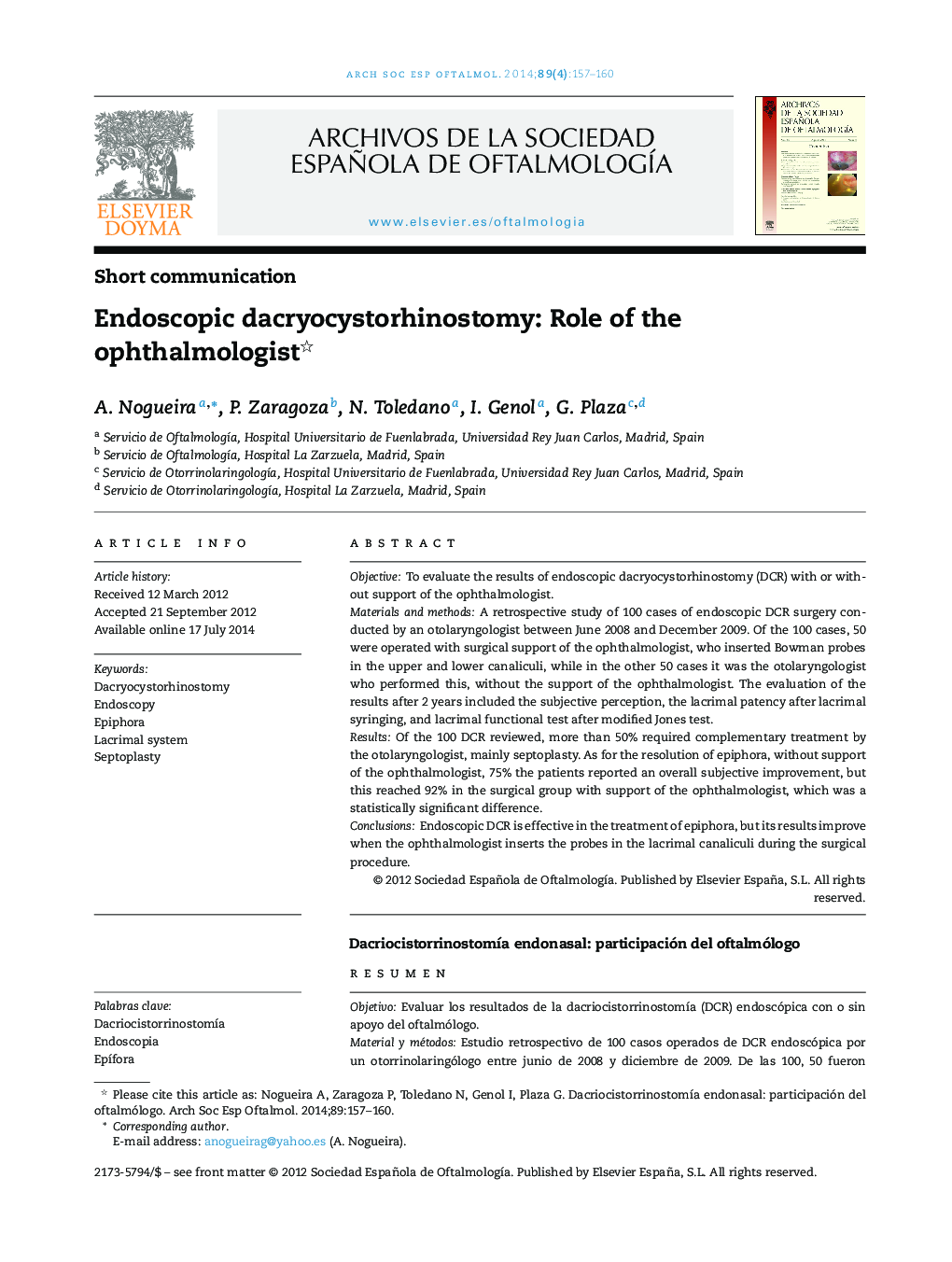| کد مقاله | کد نشریه | سال انتشار | مقاله انگلیسی | نسخه تمام متن |
|---|---|---|---|---|
| 4008283 | 1260860 | 2014 | 4 صفحه PDF | دانلود رایگان |

ObjectiveTo evaluate the results of endoscopic dacryocystorhinostomy (DCR) with or without support of the ophthalmologist.Materials and methodsA retrospective study of 100 cases of endoscopic DCR surgery conducted by an otolaryngologist between June 2008 and December 2009. Of the 100 cases, 50 were operated with surgical support of the ophthalmologist, who inserted Bowman probes in the upper and lower canaliculi, while in the other 50 cases it was the otolaryngologist who performed this, without the support of the ophthalmologist. The evaluation of the results after 2 years included the subjective perception, the lacrimal patency after lacrimal syringing, and lacrimal functional test after modified Jones test.ResultsOf the 100 DCR reviewed, more than 50% required complementary treatment by the otolaryngologist, mainly septoplasty. As for the resolution of epiphora, without support of the ophthalmologist, 75% the patients reported an overall subjective improvement, but this reached 92% in the surgical group with support of the ophthalmologist, which was a statistically significant difference.ConclusionsEndoscopic DCR is effective in the treatment of epiphora, but its results improve when the ophthalmologist inserts the probes in the lacrimal canaliculi during the surgical procedure.
ResumenObjetivoEvaluar los resultados de la dacriocistorrinostomía (DCR) endoscópica con o sin apoyo del oftalmólogo.Material y métodosEstudio retrospectivo de 100 casos operados de DCR endoscópica por un otorrinolaringólogo entre junio de 2008 y diciembre de 2009. De las 100, 50 fueron intervenidas con apoyo quirúrgico de un oftalmólogo, que canalizaba los canalículos superior e inferior con sondas de Bowman, mientras que en los otros 50 casos fue el propio otorrinolaringólogo quién realizó esta canalización, sin apoyo del oftalmólogo. La evaluación de los resultados a 2 años incluyó la percepción subjetiva, la permeabilidad de la vía lagrimal tras lavado y la permeabilidad funcional de la vía lagrimal tras test de Jones modificado.ResultadosDe las 100 DCR revisadas, en más del 50% se realizó algún tratamiento complementario por el otorrinolaringólogo, sobre todo septoplastias. En cuanto a la resolución de la epífora, cuando no hubo oftalmólogo presente en el quirófano, los pacientes referían mejoría subjetiva total en 75%; sin embargo, en el grupo cuya canalización quirúrgica era realizada por el oftalmólogo, los resultados satisfactorios llegaban al 92% de forma subjetiva, diferencia estadísticamente significativa.ConclusionesLa DCR endoscópica es efectiva en el tratamiento de la epífora, pero sus resultados mejoran cuando el oftalmólogo colabora en el procedimiento quirúrgico, canalizando la vía lagrimal.
Journal: Archivos de la Sociedad Española de Oftalmología (English Edition) - Volume 89, Issue 4, April 2014, Pages 157–160